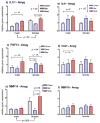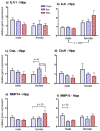Novel odors affect gene expression for cytokines and proteinases in the rat amygdala and hippocampus
- PMID: 23103411
- PMCID: PMC3501538
- DOI: 10.1016/j.brainres.2012.10.034
Novel odors affect gene expression for cytokines and proteinases in the rat amygdala and hippocampus
Abstract
Olfaction in rodents provides an excellent modality for the study of cellular mechanisms of information processing and storage, since a single occurrence of precisely timed stimuli has high survival value. We have followed up preliminary evidence of cytokine and proteinase involvement in normal (as opposed to pathologically-induced) brain plasticity by surveying for the presence of these factors in the olfactory circuitry of the rat. Genes for 25-30 common cytokines and their receptors, and over 30 cell matrix and adhesion molecules were found to be expressed across the olfactory bulb, insular cortex, amygdala, and dorsal hippocampus. We then measured by real-time PCR the transcriptional expression of seven of these genes following a one-time exposure to the novel odor of blueberry bars or cornnuts, in contrast to presentation of the familiar odor of lab chow. In the amygdala significant up-regulation of interleukin-1 receptor 1 (IL1r1), interleukin-4 receptor (IL4r), fibroblast growth factor 13 (FGF13), and cathepsin-H (CtsH) was observed in males in response to the odor of cornnuts only. Changes were less consistent and widespread in the hippocampus, but were again sex specific for three genes: cathepsin-L (CtsL), matrix metalloproteinase-14 (MMP-14) and MMP-16. Our results show that transcription for several specific cytokines, growth factors, and proteinases responds to a one-time exposure to a novel odor, in a manner that tends to be region- and sex-specific. This suggests considerable variation in the way that olfactory information is processed at the cellular level in different brain regions and by the two sexes.
Copyright © 2012 Elsevier B.V. All rights reserved.
Figures



References
-
- Bar-Or A, Nuttall RK, Duddy M, Alter A, Kim HJ, Ifergan I, Pennington CJ, Bourgoin P, Edwards DR, Yong VW. Analyses of all matrix metalloproteinase members in leukocytes emphasize monocytes as major inflammatory mediators in multiple sclerosis. Brain. 2003;126:2738–49. - PubMed
-
- Belluscio L, Lodovichi C, Feinstein P, Mombaerts P, Katz LC. Odorant receptors instruct functional circuitry in the mouse olfactory bulb. Nature. 2002;419:296–300. - PubMed
-
- Brguljan PM, Turk V, Nina C, Brzin J, Krizaj I, Popovic T. Human brain cathepsin H as a neuropeptide and bradykinin metabolizing enzyme. Peptides. 2003;24:1977–84. - PubMed
Publication types
MeSH terms
Substances
Grants and funding
LinkOut - more resources
Full Text Sources
Molecular Biology Databases
Miscellaneous

